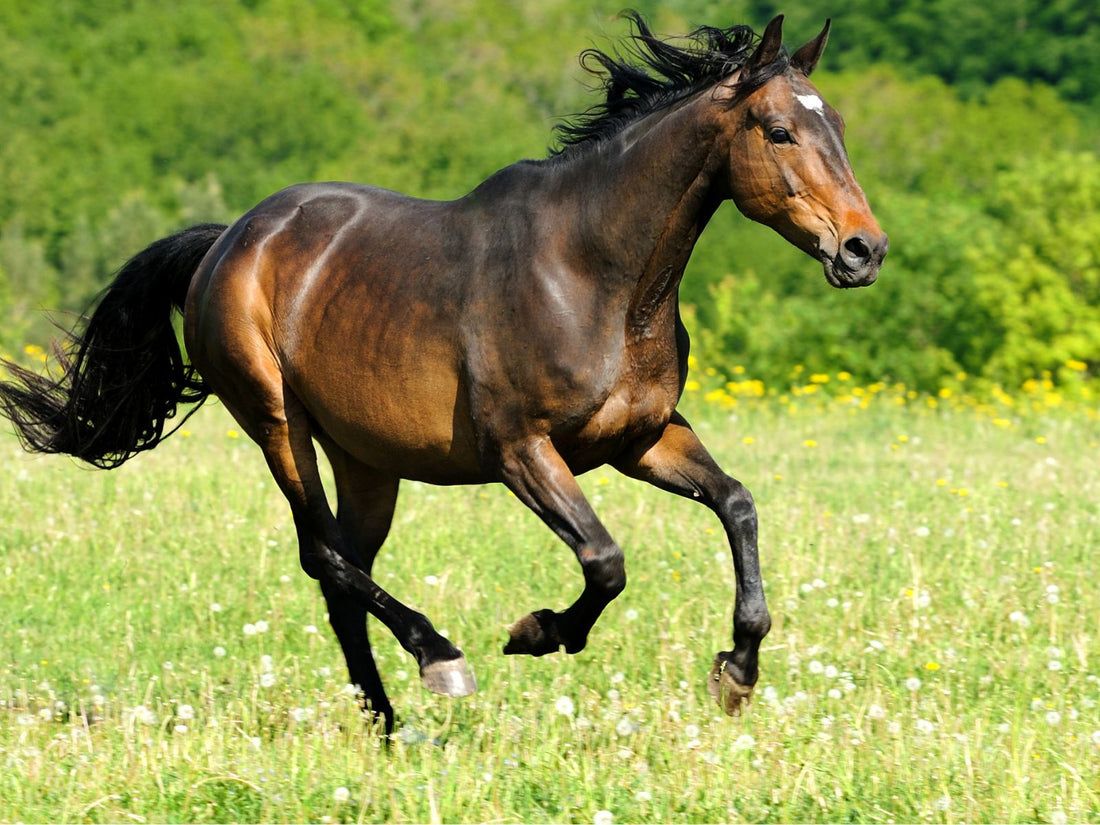
Do Horses Sweat? Understanding Equine Perspiration
Michelle DrumAs temperatures rise and the sun beats down, caring for our equine companions becomes a top priority. Among the many challenges that summer brings, ensuring your horse stays cool and comfortable is crucial. When the days get hotter, you might notice your horse sweating more than usual. In this guide, we’ll look at what happens when our horses sweat, what it means, and how to keep them cool when the temperatures rise.
Do horses sweat?
Yep, they sure do! Sweating is an essential mechanism for them to regulate their body temperature, especially during physical exertion or in hot weather. Horses have sweat glands distributed across their bodies, particularly in areas like their armpits, flanks, and between their hind legs. Sweating helps them cool down by evaporating from their skin surface, similar to how humans sweat.
Is horse sweat healthy?
Yes, sweating is a healthy and normal physiological response for horses. Sweating helps dissipate excess heat from their bodies through evaporation, preventing overheating and heat-related illnesses like heat stroke. However, while sweating is healthy, excessive or abnormal sweating can sometimes indicate underlying issues that need attention.
Here are some things to keep in mind when you notice your horse is sweating.
- Dehydration: Excessive sweating without adequate hydration can lead to dehydration, electrolyte imbalances, and other health problems. It’s crucial to ensure that your horse can access clean water and electrolyte supplements as needed, especially during hot weather or heavy exertion.
- Electrolyte imbalance: Sweating can cause horses to lose essential electrolytes like sodium, potassium, and chloride. If these electrolytes are not replenished appropriately, it can lead to muscle cramps, fatigue, and other health issues. Providing electrolyte supplements or balanced feed can help maintain electrolyte balance.
- Overheating: While sweating helps horses cool down, if they cannot adequately dissipate heat due to factors like high humidity, poor ventilation, or excessive tack, they may still be at risk of overheating despite sweating. It’s important to provide adequate cooling measures as soon as possible to prevent overheating.
- Underlying health conditions: Excessive or abnormal sweating can sometimes be a symptom of underlying health conditions like fever, metabolic disorders, or hormonal imbalances. If a horse is sweating excessively without apparent cause or other concerning symptoms accompany the sweating, you should consult your veterinarian for evaluation and diagnosis.
What happens when a horse sweats?
When a horse sweats, it undergoes a physiological process called thermoregulation to regulate its body temperature. Here’s how it works.
- Stimulation of sweat glands: When a horse’s body temperature rises, the brain signals the sweat glands to produce sweat.
- Production of sweat: Sweat is primarily composed of water, electrolytes (sodium, potassium, and chloride), and small amounts of waste products. As sweat glands secrete sweat onto the skin’s surface, it forms a thin film.
- Evaporation: The sweat on the horse’s skin absorbs heat from the body. As air passes over the skin, the moisture evaporates, carrying away heat from the horse’s body.
- Cooling effect: As sweat evaporates, it cools the skin surface and, consequently, the underlying blood vessels, which helps lower the horse’s body temperature and prevent overheating.
- Loss of fluid and electrolytes: While sweating is an effective cooling mechanism, it also results in the loss of water and electrolytes from the horse’s body. Both must be replenished by drinking water and consuming electrolytes to maintain hydration and electrolyte balance.
What causes horses to sweat?
Exercise
Physical activity is one of the main reasons why horses sweat. Your horse will likely start sweating when they engage in physical activity like riding, running, or even brisk walking. As they exert themselves, their muscles generate heat, and sweating helps dissipate this heat to maintain their body temperature within a healthy range.
Heat
Hot weather can cause horses to sweat as their bodies try to cool down. When the external temperature rises, horses sweat to release heat through evaporation from their skin.
Stress
Stressful situations, like being transported, encountering unfamiliar environments, or encountering predators, can trigger sweating in horses. This response is part of their natural fight-or-flight reaction to perceived threats.
Illness
Fever, pain, or metabolic disorders can also cause sweating in horses. In these cases, sweating may be a symptom of an underlying health issue and should be evaluated by your veterinarian.
Overheating
If your horse is in an environment with poor ventilation, it could become overheated, leading to excessive sweating as the body tries to regulate its temperature. Overheating can lead to heat stress and heat stroke, which can be life-threatening to your horse.
What is anhidrosis?
Anhidrosis, or hypohidrosis, is characterized by the inability to sweat or insufficient sweating in response to heat or exercise. Anhidrosis is particularly concerning in horses because sweating is their primary mechanism for regulating body temperature, especially during exercise or in hot environments. When horses cannot sweat adequately, they become more susceptible to heat-related illnesses like heat stroke and exertional rhabdomyolysis (tying-up).
Symptoms of anhidrosis in horses may include:
- Reduced or absent sweating, particularly in areas where sweat glands are most active, like the flanks, chest, and neck.
- Elevated body temperature during exercise or in hot weather.
- Rapid breathing and increased heart rate.
- Lethargy, weakness, or reluctance to work.
- Dry, hot skin.
- Excessive panting or rapid breathing.
The exact cause of anhidrosis in horses is not fully understood, but it is believed to be multifactorial and may involve a combination of genetic predisposition, environmental factors, and stress. Certain breeds, like Thoroughbreds and Warmbloods, are thought to be more predisposed to developing anhidrosis.
You may also like: 11 Common Horse Skin Conditions and How to Treat Them
What to do if your horse isn’t sweating
If your horse isn’t sweating adequately, it could indicate a potential problem with its thermoregulatory system or underlying health issues. Inadequate sweating can lead to overheating, dehydration, and electrolyte imbalances, seriously affecting your horse’s health.
Here are steps to take if your horse isn’t sweating:
1. Assess the situation
Monitor your horse closely to determine the severity of the issue. Look for signs of overheating, like increased respiratory rate, elevated body temperature, excessive panting, lethargy, or reluctance to move.
2. Move to a cool area
If your horse is showing signs of overheating, move it to a shaded or cooler area immediately to prevent further heat stress. If you’re in the middle of transporting your horse, park your horse trailer in a shaded area and let your horse out of the trailer if possible.
Learn more: How to Keep Your Horse Cool in a Trailer
3. Provide water
Offer your horse access to cool, fresh water to help hydrate and cool its body. Encourage drinking by adding electrolytes to the water or offering electrolyte supplements. You can also encourage your horse to drink water by adding floating alfalfa cubes. While the horse bobs for the cubes, they’ll also drink the water.
4. Cooling measures
In extreme situations, you can hose your horse with cool water or apply cold towels to its body to help lower its temperature. Avoid ice-cold water, as this can constrict blood vessels and prevent heat dissipation. Fans can also be extremely helpful in cooling off your horse.
5. Consult your veterinarian
If your horse continues to show overheating or fails to sweat despite efforts to cool it down, contact your veterinarian immediately. Inadequate sweating can indicate severe medical conditions like anhidrosis, heat stroke, electrolyte imbalances, or underlying diseases.
6. Veterinary evaluation
Your veterinarian will perform a thorough physical examination and may recommend additional diagnostic tests to identify the underlying cause of the sweating problem. Treatment will depend on the diagnosis and may include medications, dietary adjustments, or environmental management.
7. Follow veterinarian’s recommendations
Follow your veterinarian’s treatment plan and recommendations for managing your horse’s condition. This may involve changes in management practices, like adjusting turnout times, providing supplemental electrolytes, or administering medications as prescribed.
8. Monitor and prevent
Monitor your horse closely for signs of improvement and recurrence of sweating problems. Implement preventive measures to minimize the risk of future episodes, like ensuring proper hydration, avoiding excessive heat and humidity, and maintaining a healthy environment for your horse.
By recognizing the importance of sweating in regulating body temperature and implementing practical strategies for heat management, you can help your horse stay comfortable and safe during the summer months. Every effort counts in keeping your horse cool and content, from providing ample shade and ventilation to offering electrolyte supplementation and monitoring hydration levels. You and your horse can enjoy even the hottest summer days together with proper care and attention.
Learn more about horse care with our other guides:
- Parts of a Horse: Horse Anatomy with Pictures (Equestrians Guide)
- Lameness in Horses: An Introductory Guide for Equestrians
- Horse Body Language: Decoding Your Horse’s Behavior
- Horse Teeth and Dental Care (Equestrians Guide)
- Horse Deworming Schedule: An Introductory Guide for Equestrians
- Do Horses Sleep Standing Up? Answering Your Questions About Horses Sleeping
